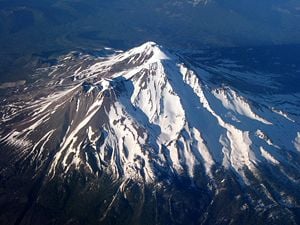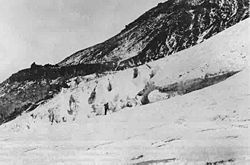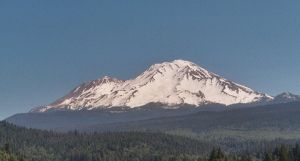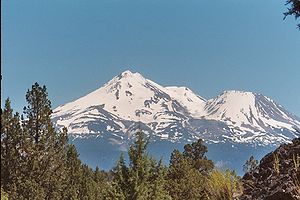Difference between revisions of "Mount Shasta" - New World Encyclopedia
m (→Geology) |
m |
||
| Line 17: | Line 17: | ||
| Easiest route = rock/ice | | Easiest route = rock/ice | ||
}} | }} | ||
| − | '''Mount Shasta''', a 14,179-foot (4,322 m)<ref name = height> </ref> [[stratovolcano]], is the second-highest peak in the [[Cascade Range]] and the fifth highest peak in [[California]] | + | '''Mount Shasta''', a 14,179-foot (4,322 m)<ref name = height> </ref> [[stratovolcano]], is the second-highest peak in the [[Cascade Range]] and the fifth highest peak in [[California]]. It is a member of the "fourteener" club (mountains with an elevation of 14,000 feet or greater)and also a member of the [[Cascade Volcanic Belt]]. Located in Siskiyou County, Mount Shasta has an estimated volume of 108 cubic miles (450 km³), making it the most voluminous stratovolcano of the Cascades.<ref>{{cite book | last = Orr | first = Elizabeth L. | coauthors = William N. Orr | title = Geology of the Pacific Northwest | publisher = The McGraw-Hill Companies | date = 1996 | location = New York | pages = 115 | id = ISBN 0-07-048018-4}}</ref> Physically unconnected to any nearby mountain, and rising abruptly from miles of level ground which encircle it, Mount Shasta stands some 10,000 feet (3,000 m) above the surrounding area. |
Shasta was memorably described by the poet Joaquin Miller: "Lonely as God, and white as a winter moon, Mount Shasta starts up sudden and solitary from the heart of the great black forests of Northern California."<ref name = Miller>{{cite book | last = Miller | first = Joaquin | title = Life amongst the Modocs: unwritten history | publisher = Heyday Books; reprint edition (January 1996)| date = 1873 | location = Berkeley | id = ISBN 0-930588-79-7}}</ref> | Shasta was memorably described by the poet Joaquin Miller: "Lonely as God, and white as a winter moon, Mount Shasta starts up sudden and solitary from the heart of the great black forests of Northern California."<ref name = Miller>{{cite book | last = Miller | first = Joaquin | title = Life amongst the Modocs: unwritten history | publisher = Heyday Books; reprint edition (January 1996)| date = 1873 | location = Berkeley | id = ISBN 0-930588-79-7}}</ref> | ||
| Line 23: | Line 23: | ||
==Geology== | ==Geology== | ||
[[image:Shasta from south.jpg|thumb|left|Shasta from the south, taken near Dunsmuir, California. Shastina is the satellite cone on the left.]] | [[image:Shasta from south.jpg|thumb|left|Shasta from the south, taken near Dunsmuir, California. Shastina is the satellite cone on the left.]] | ||
| − | The mountain consists of four overlapping volcanic cones which have built a complex shape, including the main summit and the prominent [[satellite cone]] of 12,330 feet (3,758 m) Shastina which has a visibly conical form (see image at left). Mount Shasta's surface is relatively free of deep glacial [[erosion]] except, paradoxically, for its south side where Sergeants Ridge runs parallel to the U-shaped valley, Avalanche Gulch. This is the largest glacial valley on the volcano, although it does not presently have a glacier in it (see image below left). | + | The mountain consists of four overlapping volcanic cones which have built a complex shape, including the main summit and the prominent [[satellite cone]] of 12,330 feet (3,758 m) Shastina, which has a visibly conical form (see image at left). Mount Shasta's surface is relatively free of deep glacial [[erosion]] except, paradoxically, for its south side where Sergeants Ridge runs parallel to the U-shaped valley, Avalanche Gulch. This is the largest glacial valley on the volcano, although it does not presently have a glacier in it (see image below left). |
There are eight named glaciers on Shasta, with the four largest (Whitney, Bolam, Hotlum, and Wintun) radiating down from high on the main summit cone to below 10000 ft (3000 m) primarily on the north and east sides. The Whitney Glacier is the longest and the Hotlum is the most voluminous glacier in the state of California. Three of the smaller named glaciers occupy cirques, which are amphitheatre-like valleys of glacial origin formed by glacial erosion at the head of the glacier, and are above 11000 ft (3300 m) on the south and southeast sides, including the Watkins, Konwakiton, and Mud Creek Glaciers. | There are eight named glaciers on Shasta, with the four largest (Whitney, Bolam, Hotlum, and Wintun) radiating down from high on the main summit cone to below 10000 ft (3000 m) primarily on the north and east sides. The Whitney Glacier is the longest and the Hotlum is the most voluminous glacier in the state of California. Three of the smaller named glaciers occupy cirques, which are amphitheatre-like valleys of glacial origin formed by glacial erosion at the head of the glacier, and are above 11000 ft (3300 m) on the south and southeast sides, including the Watkins, Konwakiton, and Mud Creek Glaciers. | ||
Revision as of 04:35, 5 April 2007
| Mount Shasta | |||
|---|---|---|---|
 Aerial view of Mount Shasta from the west | |||
| Elevation | 14,179 ft (4,322 m)[1] | ||
| Location | California, USA | ||
| Mountain range | Cascades | ||
| Prominence | 9,822 ft (2,994 m),ranked 97th | ||
| Geographic coordinates | {{#invoke:Coordinates|coord}}{{#coordinates:41|24|33.11|N|122|11|41.60|W|type:mountain_region:US | name=
}} | |
| Topographic map | USGS Mount Shasta | ||
| Type | Stratovolcano | ||
| Geologic time scale | ~ 593 kyr | ||
| Last eruption | 1786 | ||
| First ascent | 1854 by E.D. Pearce and party | ||
| Easiest Climbing route | rock/ice | ||
Mount Shasta, a 14,179-foot (4,322 m)[1] stratovolcano, is the second-highest peak in the Cascade Range and the fifth highest peak in California. It is a member of the "fourteener" club (mountains with an elevation of 14,000 feet or greater)and also a member of the Cascade Volcanic Belt. Located in Siskiyou County, Mount Shasta has an estimated volume of 108 cubic miles (450 km³), making it the most voluminous stratovolcano of the Cascades.[2] Physically unconnected to any nearby mountain, and rising abruptly from miles of level ground which encircle it, Mount Shasta stands some 10,000 feet (3,000 m) above the surrounding area.
Shasta was memorably described by the poet Joaquin Miller: "Lonely as God, and white as a winter moon, Mount Shasta starts up sudden and solitary from the heart of the great black forests of Northern California."[3]
Geology
The mountain consists of four overlapping volcanic cones which have built a complex shape, including the main summit and the prominent satellite cone of 12,330 feet (3,758 m) Shastina, which has a visibly conical form (see image at left). Mount Shasta's surface is relatively free of deep glacial erosion except, paradoxically, for its south side where Sergeants Ridge runs parallel to the U-shaped valley, Avalanche Gulch. This is the largest glacial valley on the volcano, although it does not presently have a glacier in it (see image below left).
There are eight named glaciers on Shasta, with the four largest (Whitney, Bolam, Hotlum, and Wintun) radiating down from high on the main summit cone to below 10000 ft (3000 m) primarily on the north and east sides. The Whitney Glacier is the longest and the Hotlum is the most voluminous glacier in the state of California. Three of the smaller named glaciers occupy cirques, which are amphitheatre-like valleys of glacial origin formed by glacial erosion at the head of the glacier, and are above 11000 ft (3300 m) on the south and southeast sides, including the Watkins, Konwakiton, and Mud Creek Glaciers.
There are many buried glacial scars on the mountain which were originally created in recent glacial periods ("ice ages") of the present Wisconsinian glaciation. Most have since been filled-in with andesite lava, pyroclastic flows, and talus from lava domes. Shastina, by comparison, has a fully intact summit crater indicating that Shastina developed after the last ice age.
About 593,000 years ago andesitic lavas erupted in what is now Mount Shasta's western flank near McBride Spring. Over time an ancestral Shasta stratovolcano was built to large but unknown height; sometime between 300,000 to 360,000 years ago the entire north side of the volcano collapsed, creating an enormous landslide or debris avalanche, 6.5 mile³ (27 km³) in volume. The slide flowed northwestward into Shasta Valley where the Shasta River now cuts through the 28 mile (45 km) long flow.
What remains of the oldest of Shasta's four cones is exposed at Sergeants Ridge on the south side of the mountain. Lavas from the Sergeants Ridge vent cover the Everitt Hill shield at Shasta's southern foot. The last lavas to erupt from the vent were hornblende-pyroxene andesites with a hornblende dacite dome at its summit. Glacial erosion has since modified its shape.
The next cone to form is exposed south of Shasta's current summit and is called Misery Hill. It was formed 15,000 to 20,000 years ago from pyroxene andesite flows and has since been intruded by a hornblende dacite dome.
Since then the Shastina cone has been built by mostly pyroxene andesite lava flows. Some 9500 years ago, these flows reached about 6.8 miles (11 km) south and three miles north of the area now occupied by nearby Black Butte (see image at right). The last eruptions formed Shastina's present summit about a hundred years later. But before that, Shastina, along with the then forming Black Butte dacite plug dome complex to the west, created numerous pyroclastic flows that covered 43 mile² (110 km²), including large parts of what is now Mt. Shasta, California and Weed, California. Diller Canyon (400 ft (120 m) deep and quarter-mile (400 m) wide) is an avalanche chute that was probably carved into Shastina's western face by these flows.
The last to form, and the highest cone, the Hotlum Cone, formed about 8000 years ago. It is named after the Hotlum glacier on its northern face; its longest lava flow, the 500 ft (150 m) thick Military Pass flow, extends 5.5 miles (9 km) down its northwest face. Since the creation of the Hotlum Cone, a dacite dome intruded the cone and now forms the summit. The rock at the 600 ft (180 m) wide summit crater has been extensively hydrothermally altered by sulfurous hot springs and fumaroles there (only a few examples still remain).
In the last 8000 years, the Hotlum Cone has erupted at least eight or nine times. About 200 years ago the last significant Shasta eruption came from this cone and created a pyroclastic flow, a hot lahar (mudflow), and three cold lahars, which streamed 7.5 miles (12 km) down Shasta's east flank via Ash Creek. A separate hot lahar went 12 miles (19 km) down Mud Creek.
Climbing
Mount Shasta sees many climbers annually attempt to make it to the summit. The summer climbing season runs from late April until October, although many attempts are made in the winter. The most popular route is Avalanche Gulch; however in winter, Sargent's Ridge and Cassaval Ridge become the most traveled routes. Because Mount Shasta is a very popular mountain for climbers in the summertime, it sees many inexperienced climbers who become in need of rescue. The Siskiyou County CHP Helicopter performs these rescues.[citation needed]
Volcanic hazards
During the last 10,000 years Shasta has erupted an average of every 800 years but in the past 4500 years the volcano has erupted an average of every 600 years. The last significant eruption on Shasta may have occurred 200 years ago.
Mount Shasta can release volcanic ash, pyroclastic flows or dacite and andesite lava. Its deposits can be detected under nearby small towns totalling 20,000 in population. Shasta has an explosive, eruptive history. There are fumaroles on the mountain, which show that Shasta is still alive.
The worst case scenario for an eruption is a large pyroclastic flow, such as what occurred in the 1980 eruption of Mount St. Helens. Since there is ice, such as Whitney Glacier and Mud Creek Glacier, lahars would also result. Ash would probably blow inland, perhaps as far as eastern Nevada. There is a small chance that an eruption could also be bigger resulting in a collapse of the mountain, as happened at Mount Mazama in Oregon, but this is of much lower probability.
The United States Geological Survey considers Shasta a dormant volcano, which will erupt again. It is impossible to pinpoint the date of next eruption, but it likely will occur within the next several hundred years.
History
The oldest human habitation in the area dates to about 7000 years ago, and by about 5000 years ago, there was substantial human habitation in the surrounding area.
At the time of Euro-American contact in the 1820s, the Native American tribes who lived within view of Mount Shasta included the Shasta, Okwanuchu, Modoc, Achomawi, Atsugewi, Karuk, Klamath, Wintu, and Yana tribes.
Although perhaps first seen by Spanish explorers, the first reliably-reported sighting of Mount Shasta by a European or American was by Peter Skene Ogden (a leader of a Hudson's Bay Company trapping brigade) in 1826. In 1827, the name "Sasty" or "Sastise" was given to nearby Mount McLoughlin by Ogden. (The name was transferred to present-day Mount Shasta in 1841, partly as a result of work by the United States Exploring Expedition).
Beginning in the 1820s, Mount Shasta was a prominent landmark along what became known as the Siskiyou Trail, which runs at Mount Shasta's base. The Siskiyou Trail was located on the track of an ancient trade and travel route of Native American footpaths between California's Central Valley and the Pacific Northwest.
The California Gold Rush brought the first Euro-American settlements into the area in the early 1850s, including at Yreka, California and Upper Soda Springs. The first recorded ascent of Mount Shasta occurred in 1854 (by Elias Pearce), after several earlier failed attempts. In 1856, the first women (Harriette Eddy, Mary Campbell McCloud, and their party) were recorded as reaching the summit.

By the 1860s and 1870s, Shasta was the subject of scientific and literary interest. The summit was achieved (or nearly achieved) by John Muir, Josiah Whitney, Clarence King, and John Wesley Powell. In 1877, Muir wrote a dramatic popular article about an experience in which he survived an overnight blizzard on Shasta by lying in the hot sulphur springs found near the summit (Muir article).
The 1887 completion of the Central Pacific Railroad, built along the line of the Siskiyou Trail between California and Oregon, brought a substantial increase in tourism, lumbering, and population into the area around Mount Shasta. Early resorts and hotels, such as Shasta Springs, grew up along the Siskiyou Trail around Mount Shasta, catering to these early adventuresome tourists and mountaineers.
In the early Twentieth Century, the Pacific Highway followed the track of the Siskiyou Trail to the base of Mount Shasta, leading to still more access to the mountain. Today's version of the Siskiyou Trail, Interstate 5, brings thousands of people a year to Mount Shasta.
Today, the area remains one of California's premiere tourist destinations, attracting travelers from around the world.
Religion
The lore of some of the Native Americans in the area held that Shasta is inhabited by the spirit chief Skell who descended from heaven to the mountain's summit.
Many other faiths have been attracted to Shasta over the years — more than any other Cascade volcano. Mount Shasta City and Dunsmuir, California, small towns near Shasta's western base, are focal points for many of these, which range from a Buddhist monastery (Shasta Abbey, founded by Houn Jiyu-Kennett in 1971) to modern-day Native American rituals. As reported in the documentary In The Light of Reverence, a group of Native Americans from the McCloud River area practice rituals on the mountain.
Guy Ballard's I Am Activity (started in the 1930s) and Elizabeth Clare Prophet's Church Universal and Triumphant (started in the 1950s) are probably the best-known among numerous groups to participate in Shasta's spiritual heritage. Some cults hold that races of sentient or spiritual beings, superior to humans, live in or on Shasta, or visit the mountain.
Mount Shasta City hosts 16 Christian churches. If the membership rolls were combined, they would account for approximately 25 percent of the population.
Cultural references
- Joaquin Miller sets his historical novel, Life Amongst the Modocs,[3] at the base of Mt. Shasta. The poet had spent a number of years as a young man living with and near the Native Americans around Mt. Shasta, and based this work on that time. The first line of the novel is quoted in the first paragraph (above) of this article. Miller also refers to Mt. Shasta repeatedly in his poems and other book-length works, including, for example, Shadows of Shasta.
- Frederick Spencer Oliver's fantasy novel, A Dweller On Two Planets, is about the Lemurian race. In the novel, Lemurians who traveled to Mount Shasta when their continent sank beneath the Pacific Ocean, are now said to live inside the mountain in a series of tunnels. Many people claimed to have encountered Lemurians on Shasta.
- Mt. Shasta is mentioned in Lost Legacy, a speculative fiction short story by Robert A. Heinlein as the home of a group of men who are masters of psychic powers and who decide to teach the world their powers by enlisting Boy Scouts.
- The mountain is also part of a key scene in Ken Grimwood's novel Replay.
- Mt. Shasta inspired singer-songwriter Vienna Teng's song Shasta on her second album Warm Strangers.
- Mt. Shasta is the home to and namesake of the Taiko drumming group Shasta Taiko.
Notes
- ↑ 1.0 1.1 The height of Mt. Shasta has traditionally been given as 14,161 feet (or 14,162 feet) — however, the most recent height listed by the U.S. government is 14,179 feet. Elevations on "USGS quad maps" are not the most up to date elevations, because they are only updated at 20 to 30 year intervals. To find the most recent elevation of Mt. Shasta, visit the National Geodetic Survey web site. Click on "datasheets". Click on the "DATASHEETS" button. Click on "Radial Search". For Mount Shasta, enter N412433 for Latitude, W1221142 for Longitude. Click the "Submit" button. Click "Select All". Click "Get Datasheets". At the bottom of the page, the indication "NAVD 88" appears, indicating the elevation in the NAVD88 coordinate system, as of the epoch date (here, 1991). The elevation given of 14,179 feet is the latest, most accurate, elevation.
- ↑ Orr, Elizabeth L. and William N. Orr (1996). Geology of the Pacific Northwest. New York: The McGraw-Hill Companies, 115. ISBN 0-07-048018-4.
- ↑ 3.0 3.1 Miller, Joaquin (1873). Life amongst the Modocs: unwritten history. Berkeley: Heyday Books; reprint edition (January 1996). ISBN 0-930588-79-7.
Sources and Further Reading
- Selters, Andrew; Zanger, Michael, The Mt. Shasta book : a guide to hiking, climbing, skiing, and exploring the mountain and surrounding, California, Wilderness Press, 2006, ISBN 089997404X
- Harris, Stephen L, Fire mountains of the West : the Cascade and Mono Lake, Montana, Mountain Press Pub. Co., 2005, ISBN 087842511X
- Wood, Charles Arthur; Kienle, Juergen, Volcanoes of North America : United States and Canada, England; New York, Cambridge University Press, 1992, ISBN 052143811X
See also
- High Cascades
- Cascade Volcanic Belt
- Mount Rainier
- Mount St. Helens
- Mount Adams
- Glacier Peak
- Mount Baker
- Mount Hood
- Crater Lake
- Mount Lassen
- List of California fourteeners
External links
- January 27- 28, 2007, Mt. Shasta Rescue, Mt. Shasta, Accessed March 19, 2007
- Shasta, Global Volcanism Program, Accessed March 19, 2007
- Mount Shasta, TierraWiki, Accessed March 19, 2007
- The Mount Shasta Collection, College of the Siskiyous, Accessed March 19, 2007
- February 21, 2006, Mount Shasta, Summit Post, Accessed March 19, 2007
- Mount Shasta, California, Peak Bagger, Accessed March 19, 2007
- Mount Shasta California, Bivouac, Accessed March 19, 2007
- Miesse, William C., June 17, 2005, Mount Shasta Fact Sheet, College of the Siskiyous, Accessed March 19, 2007
- Mount Shasta Herald, September 25, 1888, The First Female, College of the Siskiyous, Accessed March 19, 2007
- Maps and aerial photos
- WikiSatellite view at WikiMapia
- Topographic map from TopoZone
- Surrounding area map from Google Maps
- Location in the United States from the Census Bureau
| Major Cascade Volcanoes | 
|
|---|---|
| Mount Silverthrone | Mount Meager | Mount Cayley | Mount Garibaldi | Mount Baker | Glacier Peak | Mount Rainier | Mount St. Helens | Mount Adams | Mount Hood | Mount Jefferson | Three Sisters | Newberry Volcano | Mount Mazama | Mount McLoughlin | Medicine Lake Volcano | Mount Shasta | Lassen Peak |
Credits
New World Encyclopedia writers and editors rewrote and completed the Wikipedia article in accordance with New World Encyclopedia standards. This article abides by terms of the Creative Commons CC-by-sa 3.0 License (CC-by-sa), which may be used and disseminated with proper attribution. Credit is due under the terms of this license that can reference both the New World Encyclopedia contributors and the selfless volunteer contributors of the Wikimedia Foundation. To cite this article click here for a list of acceptable citing formats.The history of earlier contributions by wikipedians is accessible to researchers here:
The history of this article since it was imported to New World Encyclopedia:
Note: Some restrictions may apply to use of individual images which are separately licensed.






